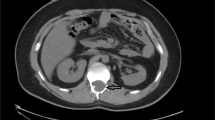Abstract
Study design:
Case report.
Objective:
To present a case of spinal cord injury (SCI)-associated neuropathic pain treated with botulinum toxin A injection.
Setting:
Outpatient SCI clinic.
Case report:
Description of a case in the context of relevant literature on the subject.
Results:
A 51-year-old man with C3 AIS B tetraplegia (American Spinal Injury Association Impairment Scale B) visited our outpatient clinic due to severe ongoing neuropathic pain and associated allodynia and dysesthesia of the lower limbs. He had previously tried combinations of pregabalin, gabapentin and oxycontin but all failed to alleviate his neuropathic pain during the 2 years post trauma. With the patient’s consent, he was treated with subcutaneous injections of clostridium type A botulinum toxin. Ten units of type A botulinum toxin subcutaneously injected into 10 most painful sites of each sole. The patient was reassessed at 4 and 8 weeks after his injection with botulinum toxin with significant improvement of his neuropathic pain.
Conclusion:
Subcutaneous injection of type A botulinum toxin was effective without side effects, on one case of refractory neuropathic pain due to SCI. This is the first article to report the use of type A botulinum toxin in neuropathic pain related to traumatic SCI.
Similar content being viewed by others
Introduction
Pain has increasingly been recognized as an important contributor to reduced quality of life and worse rehabilitation outcomes after spinal cord injury (SCI). However, a substantial percentage of patients with SCI neuropathic pain do not obtain significant pain relief from existing treatments. We report substantial improvement of neuropathic pain related to traumatic SCI in one patient after subcutaneous administration of type A botulinum toxin. This is the first article to report on the use of type A botulinum toxin in neuropathic pain related to traumatic SCI.
Case report
A 51-year-old man with C3 AIS B tetraplegia (American Spinal Injury Association Impairment Scale B) visited our outpatient clinic due to severe neuropathic pain of the lower limbs 2 years after a traffic accident-related cervical SCI. The neuropathic pain appeared 1 day after trauma onset. The patient’s pain was compatible with the proposed definite criteria for SCI neuropathic pain.1 He had no past history that would imply possible underlying peripheral neuropathy.
Detailed assessment of his neuropathic pain was performed according to the recommendations provided by the International Spinal Cord Injury Pain Data Set. The pain occurred below the neurologic injury level and was both spontaneous (stimulus independent) and evoked (stimulus dependent). The spontaneous neuropathic pain occurred continuously in the lower limbs with a visual analog scale (VAS) of 41 mm above the ankle, and a VAS of 96 mm with paroxysmal bursts of VAS 100 mm neuralgia below the ankles. The intermittent bursts of pain occurred on an average of 3–6 times a day randomly. Temporal variations were present with nocturnal worsening of neuropathic pain and VAS increasing above baseline levels of 96 mm in the soles. Pain qualities of the spontaneous neuropathic pain included a combination of ‘burning’, ‘sharp’, ‘tingling’ and ‘cold’ sensations. The intermittent stimulus-evoked neuropathic pain was ‘electric shock-like’ and was most often provoked by moderate brushing of the lower extremities with VAS scores of 100 mm.
He was being prescribed 150 mg of pregabalin and 150 mg of an extended release form of tramadol three times a day for his neuropathic pain. He had previously tried combinations of pregabalin, gabapentin and oxycontin but all failed to alleviate his neuropathic pain.
He was treated with subcutaneous injections of clostridium type A botulinum toxin. Type A botulinum toxin (200 units) was diluted in 2 ml of normal saline and subcutaneously injected into the 10 most painful sites of each sole. Each site was injected with 0.2 ml of the mixture, which was ∼10 units of type A botulinum toxin. No immediate side effects were present after the injection.
The patient returned to our outpatient clinic 4 weeks after his injection. The spontaneous pain, which was most severe below the ankle, decreased to a VAS score of 68 mm with the daily presenting random bursts occurring <1–2 times a week. The intensity of the paroxysmal bursts decreased to tolerable levels of VAS 42 mm. The evoked neuropathic pain improved in intensity to VAS 67 mm. The spontaneous and continuous neuropathic pain of the lower limb above the ankle did not change significantly and remained at a VAS of 39 mm.
The patient was reassessed 8 weeks after botulinum toxin injection and his spontaneous pain below the ankles improved to a VAS of 23 mm. His overall pain especially above the ankles reduced to a VAS of 21 mm.
Discussion
The International Association for the Study of Pain redefined neuropathic pain as a ‘pain caused by a lesion or disease of the somatosensory system’ and the International Spinal Cord Injury Pain Data Set further classifies neuropathic pain after SCI into at-level, below-level and other neuropathic pain.1, 2
Unlike the definition of neuropathic pain and its classification in SCI, the underlying mechanism is still elusive. Neuronal hyperexcitability is one of the main explanations proposed for the mechanism of neuropathic pain. Reorganization of the nervous system after injury and functional changes of receptors including N-methyl-D-aspartate (NMDA) and other glutamate receptors may underlie the central sensitization of spinal cord neurons to stimuli.3 Release of proinflammatory agents—such as adenosine, bradyckinin, serotonin—can also sensitize neural transmission via C- and A-delta nerve fibers and augment transmission of painful stimuli.4 Furthermore, various neuropeptides such as substance P, glutamate, calcitonin gene-related peptide (CGRP) have central roles in peripheral sensitization of nociception. Substance P is believed to sensitize primary afferents and increase local histamine and bradykinin release that is thought to amplify the process of neurogenic inflammation and aggravate C- and A-delta nerve fiber sensitization.5 In one animal study, uninjured C-fibers in the skin of primates appeared to develop alpha-adrenergic suprasensitivity and spontaneous activity after spinal nerve root ligation injury.6 This may be involved in the process of sympathetically mediated neuropathic pain. The combination of these sensitization processes are thought to contribute to malfunction of neuronal transmission after SCI and eventually lead to pain generation that continues without the presence of tissue-damaging stimulus.
Recently, the role of botulinum toxin as a treatment modality in painful neuropathic conditions is carefully being emphasized. Initially, the analgesic effects of botulinum toxin were thought to occur through reduction of muscle spasm. However, numerous animal and clinical studies suggest botulinum toxin’s contribution to pain relief on mechanisms distinct from mere inhibition of motor output.
The main analgesic effects may be attributed to decreased sensitization of nociceptive pathways through botulinum toxin’s inhibition of glutamate. Glutamate is an excitatory neurotransmitter that has been implied in neuropathic pain generation.7 Cui et al.8 showed inhibition of inflammatory pain behavior triggered by formalin in the hind paw of rats pretreated with subcutaneous injections of type A botulinum toxin, and these findings showed reduced concentrations of glutamate in the formalin-injected paw when compared with saline-injected controls. Botulinum toxin’s inhibition of excitatory neurotransmitters such as glutamate may also stabilize neuronal excitability and suppress central sensitization of spinal cord neurons to stimuli.5 Botulinum toxin has also been shown to repress substance P and CGRP hyperscretion via SNARE protein cleavage and subsequent prevention of exocytosis in rat neuronal models.9 Botulinum toxin also impairs sympathetic transmission by inhibiting preganglionic cholinergic sympathetic fibers and thus may act through sympathetic inhibition.
Only one previous case study has reported on the effect of botulinum toxin in neuropathic pain of spinal cord origin.5 Jabbari et al. postulated that spinal cord lesions causing chronic central pain sensitize the peripheral nociceptors and such peripheral sensitization through antidromic depolarization amplifies and maintains central pain. The proposed mechanism of pain alleviation through type A botutlinum toxin may have been through reduction of neurogenic inflammation and unwanted activity of certain peripheral neurotransmitters.5 Another possible explanation of pain improvement hypothesized by Jabbari et al. in SCI-related neuropathic pain was due to a direct effect of type A botulinum toxin on the spinal cord.5
Although the origin of SCI was traumatic in this case, a significant analgesic effect of neuropathic pain was achieved through subcutaneous administration of type A botulinum toxin. No apparent side effects of type A botulinum toxin administration were noted, making it a potential candidate for treating refractory and severe neuropathic pain after traumatic SCI.
Conclusion
Subcutaneous injection of type A botulinum toxin was effective without side effects on one case of refractory neuropathic pain due to SCI. However, further randomized control trials are needed to confirm type A botulinum toxin’s effect on centrally acting neuropathic pain.
References
Widerström-Noga E, Biering-Sørensen F, Bryce T, Cardenas DD, Finnerup NB, Jensen MP et al. The international spinal cord injury pain basic data set. Spinal Cord 2008; 46: 818–823.
Jensen TS, Baron R, Haanpää M, Kalso E, Loeser JD, Rice AS et al. A new definition of neuropathic pain. Pain 2011; 152: 2204–2205.
Finnerup NB, Baastrup C . Spinal cord injury pain: mechanisms and management. Curr Pain Headache Rep 2012; 16: 207–216.
Argoff CE . A focused review on the use of botulinum toxins for neuropathic pain. Clin J Pain 2002; 18 (6 Suppl): S177–S181.
Jabbari B, Maher N, Difazio MP . Botulinum toxin A improved burning pain and allodynia in two patients with spinal cord pathology. Pain Med 2003; 4: 206–210.
Ali Z, Ringkamp M, Hartke TV, Chien HF, Flavahan NA, Campbell JN et al. Uninjured C-fiber nociceptors develop spontaneous activity and alpha-adrenergic sensitivity following L6 spinal nerve ligation in monkey. J Neurophysiol 1999; 81: 455–466.
Francisco GE, Tan H, Green M . Do botulinum toxins have a role in the management of neuropathic pain?: A focused review. Am J Phys Med Rehabil 2012; 91: 899–909.
Cui M, Khanijou S, Rubino J, Aoki KR . Subcutaneous administration of botulinum toxin A reduces formalin-induced pain. Pain 2004; 107: 125–133.
Welch MJ, Purkiss JR, Foster KA . Sensitivity of embryonic rat dorsal root ganglia neurons to Clostridium botulinum neurotoxins. Toxicon 2000; 38: 245–258.
Author information
Authors and Affiliations
Corresponding author
Ethics declarations
Competing interests
The authors declare no conflict of interest.
Rights and permissions
About this article
Cite this article
Han, Z., Song, D. & Chung, M. Effect of subcutaneous injection of botulinum toxin A on spinal cord injury-associated neuropathic pain. Spinal Cord 52 (Suppl 1), S5–S6 (2014). https://doi.org/10.1038/sc.2014.43
Received:
Revised:
Accepted:
Published:
Issue Date:
DOI: https://doi.org/10.1038/sc.2014.43



